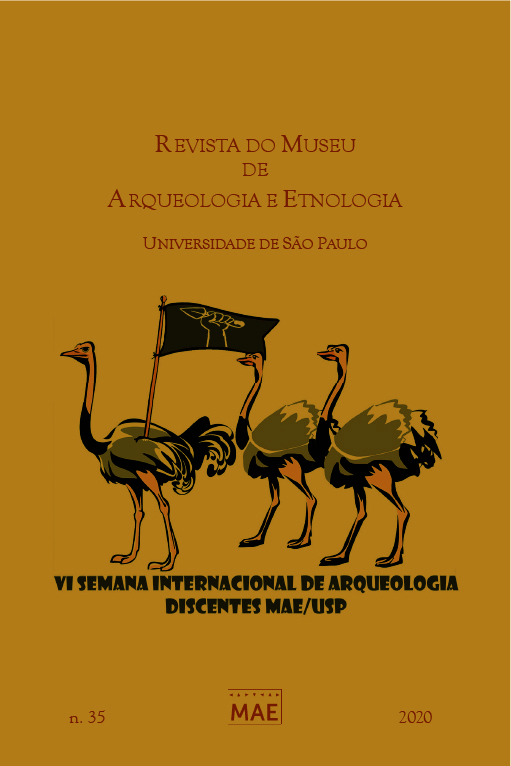Statuettes and protomes in sacred spaces of Athena, in Gela and Lindos, from the Archaic Period
DOI:
https://doi.org/10.11606/issn.2448-1750.revmae.2020.163618Keywords:
Greek world, Sicily, Rhodes, Votive terracota, AthenaAbstract
The purpose of this article is to extend a presentation made at the VI International Week of Archeology - Students - MAE - USP in 2019, as much as possible as suggestions, criticisms and questions raised during a table and the event itself. The formation of the polis was a process that took place throughout the Archaic Period in various movements, articulated to the social transformations of the late Iron Age. A religion was one of the structured elements of many of these nascent communities, being attested to the concentration of offerings in sacred public places that later descended life to the shrines, to the detriment of the immobilization of wealth in tombs, individuals or even collective. From the 8th century BC onwards also realized in materiality certain innovations such as the construction of temples, buildings for the shelter of the image of worship, an abode of god. The Greek expansion movement, which gained great expression in the archaic era with the Support Foundation along the Mediterranean and Black Seas, also contributed to the expansion of the poles in old Greece. The founders took with them a culture and a way of constructing their world material, including their gods, but as specificities of each locality tending to reshape religious practices. In this context, we analyze two types of offerings, terracotta protomes and statues, Sicilian foundations and their metropolises, to try to discern similarities and adaptations that point to possible social or cultural changes in the new communities that are formed.
Downloads
References
Blinkenberg, C.S.; Kinch, K.F. 1931. Lindos: Fouilles et recherches, 1902-1914. W. de Gruyter, Berlin.
Dewailly, M. 1992. Les statuettes aux parures du sanctuaire de la malophoros à Sélinonte. Centre Jean Bérard, Naples.
Flannery, K.V. 1994. The cultural evolution of civilizations. Annual Review of Ecology and Systematics, 3: 399-426.
Hansen, M.H.; Nielsen, T.H. 2004. The inventory of archaic and classical Greek poleis. Oxford University Press, Oxford.
Hawkes, C. 1954. Archaeological theory and method: some suggestions from the Old World. American Anthropologist, 56: 155-168.
Higgins, R.A. 1969. Catalogue of the terracottas in the department of Greek and Roman antiquities-British Museum. Trustees of the British Museum, London.
Higgins, R.A. 1963. Greek terracotta figures. Trustees of the British Museum, London.
Hirata, E.F.V. 2010. Arqueologia, religião e poder político no Ocidente Grego.Tese de Livre Docência. Universidade de São Paulo, São Paulo.
Hirata, E.F.V. 1978. As estatuetas de terracota e a religião popular da magna Grécia e Sicília. Dissertação de mestrado. Universidade de São Paulo, São Paulo.
Hirata, E.F.V. 1995. Estatuetas de terracota clássicas. Cerâmicas antigas da Quinta da Boa Vista. Catálogo de exposição. Museu Nacional de Belas Artes, Rio de Janeiro.
Hirata, E.F.V. 1992. Os prótomos femininos de Gela: uma proposta de interpretação. Revista do Museu de Arqueologia e Etnologia, 2: 49-61.
Hirata, E.F.V. 1986. Prótomos femininos de Gela: especificidade e função no quadro da coroplastia siciliota (séc VI-V a.C.). Tese de doutorado. Universidade de São Paulo, São Paulo.
Homero. 2016. Ilíada. Trad. Carlos Alberto Nunes. Nova Fronteira, Rio de Janeiro.
Karouzos, C. 1973. Rhodos, history, monuments, art. Esperos Editions, Athens.
Mollard-Besques, S. 1954. Catalogue raisonné des figurines et reliefs en terre-cuite grecs, étrusques et romains. Éditions des Musées Nationaux, Musée National du Louvre, Paris.
Renfrew. C. (Org.). 1985. The archaeology of cult: the sanctuary at Phylakopi. British School of Archaeology at Athens Thames and Hudson, London.
Renfrew, C.; Bahn, P. 1991. Archaeology: theories, methods, and practice. Thames and Hudson, New York.
Stillwell, R.; Macdonald, W.L.; Mcallister, M.H. (Eds.). 1976. The Princeton encyclopedia of classical sites. Princeton University Press, Princeton.
Tabone, D.A. 2012. Paisagem sagrada e paisagem política: os espaços sagrados de Gela, Sicília – séculos VII-III a.C. Dissertação de mestrado. Universidade de São Paulo, São Paulo.
Tabone, D.A. 2017. Sagrado e a constituição simbólica da cultura material: perspectivas teóricas e metodológicas. In: Kesser, C.B.D.; Silva, S.C.; Campos, C.E.C. (Orgs.). Experiências religiosas no mundo antigo. Editora Prismas, Curitiba, 1: 105-121.
Tataki, A.B. 1980. Rhodes, lindos, kamiros, filerimos: le palais des grands maitres et le musee. Ekdotike Athenon, Athens.
Tucídides. 2001. História da guerra do Peloponeso/Tucídides. Trad. Mario da Gama Kury. Editora Universidade de Brasília; Instituto de Pesquisa de Relações Internacionais, Brasília; Imprensa Oficial do Estado de São Paulo, São Paulo.
Veronese, F. 2006. Lospazioe la dimensione del sacro. Santuari greci e territorio nella Sicilia arcaica. Esedra Editrice, Padova.
Zuntz, G. 1971. Persephone: three essays on religion and thought in Magna Graecia. Clarendon Press, Oxford.
Downloads
Published
Issue
Section
License
Copyright (c) 2020 Felipe Leonardo Ferreira

This work is licensed under a Creative Commons Attribution-NonCommercial-NoDerivatives 4.0 International License.
Funding data
-
Fundação de Amparo à Pesquisa do Estado de São Paulo
Grant numbers Processo 2015/11899-0













